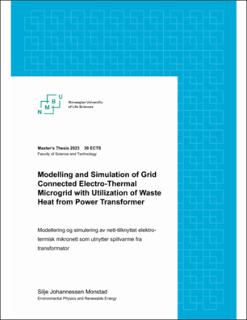| dc.description.abstract | Microgrid technology is a promising method to overcome technical challenges related to the integration of distributed intermittent renewable energy. However, effective energy storage for maintaining power balance is crucial to obtain independent operation from the utility grid. Electric heating dominates in Norway and heating purposes make up the largest share of households' total energy consumption. Substituting electricity with alternative heating methods could thereby free up electricity within microgrids. Thermal microgrids consist of low-temperature district heating networks and thermal energy storage, and could be such an alternative heating method. Furthermore, it enables better integration of low-temperature sources such as waste heat. Power transformers generate heat from stepping up and down voltage and may be such a waste heat source.
This thesis examines if implementation of thermal microgrids can boost storage capacity and strengthen the reliability of microgrids. In addition, it investigates if heat recovery from a power transformer could be a valuable source for low-temperature district heating. To examine the presented, an electro-thermal microgrid model with both battery and water tank storage has been carried out in Simulink/Simscape, where the main objective was to study power and heat flows. For comparison, a fully electrical model was also created.
Simulation results showed the power transformer could contribute greatly to the district heating network, and together with heat pump technology, the overall system performance was significantly improved compared to electricity heating. The power demand within the microgrid was significantly decreased, improving the time of running self-sufficiently by 12 %. Furthermore, it enabled the electro-thermal microgrid to netto export during the week, economically resulting in a difference of 100 000 NOK. During a grid failure scenario, the electro-thermal microgrid had more available storage capacity as the discharge rate was lower. Especially, the thermal energy storage showed it provided great flexibility and boosted the storage capacity as it could run independently for several hours.
The overall conclusion is that implementation of thermal microgrids will extend storage capacity, improve reliability and resilience, provide flexibility and increase the energy systems' performance. Additionally, power transformers are found to be great contributors to low-temperature district heating. Appropriate planning of their location to easier utilize the heat for other interests should be considered. However, it will be necessary to create the model physically and not only based on power/heat flows for more accurate simulation results. | |
